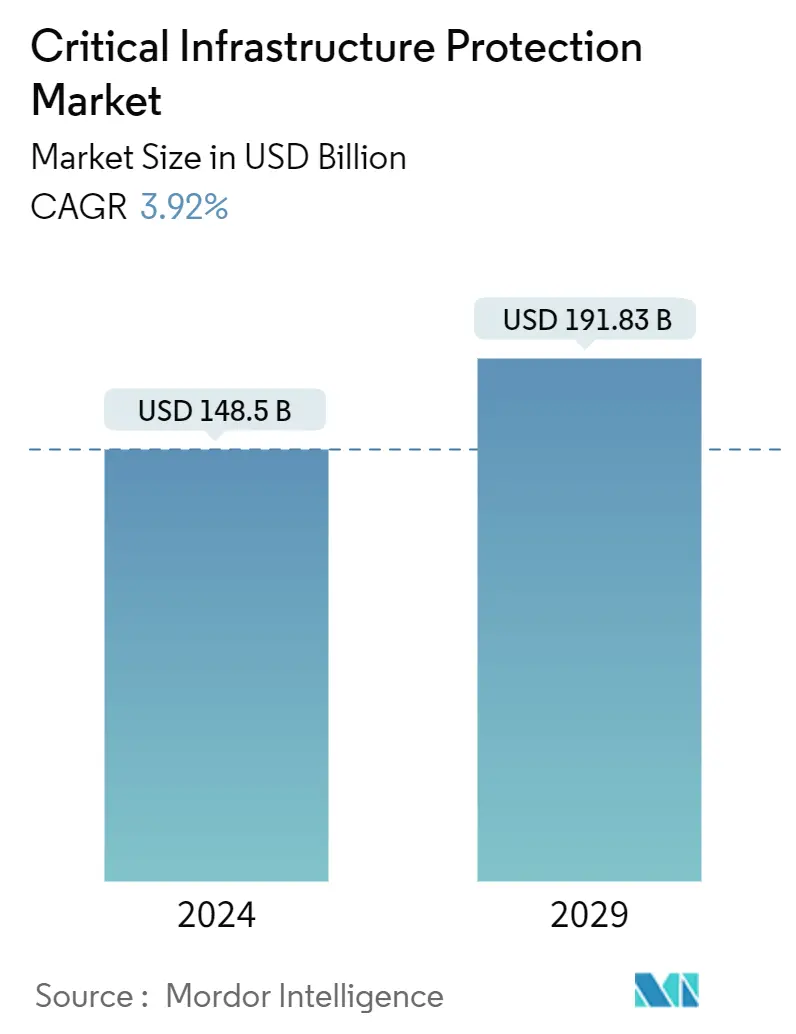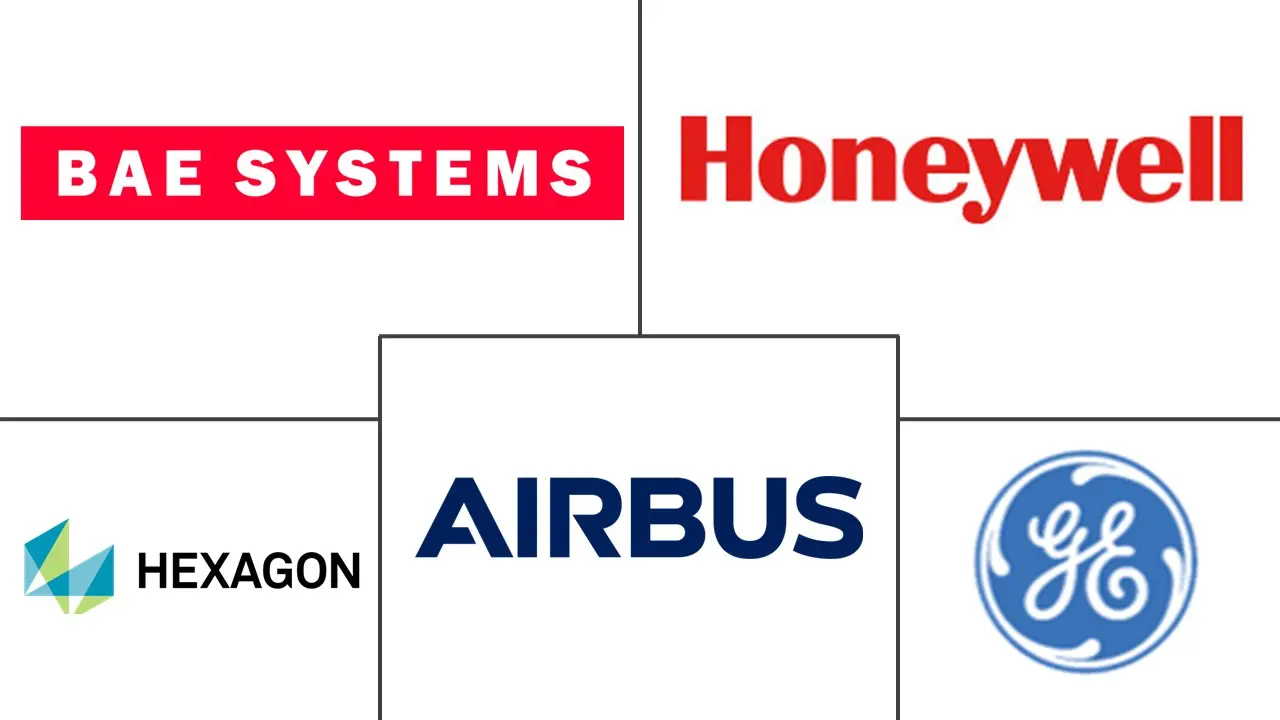Market Size of Critical Infrastructure Protection Industry

| Study Period | 2019 - 2029 |
| Market Size (2024) | USD 148.5 Billion |
| Market Size (2029) | USD 191.83 Billion |
| CAGR (2024 - 2029) | 3.92 % |
| Fastest Growing Market | Asia Pacific |
| Largest Market | North America |
Major Players
*Disclaimer: Major Players sorted in no particular order |
Critical Infrastructure Protection (CIP) Market Analysis
The Critical Infrastructure Protection Market size is estimated at USD 148.5 billion in 2024, and is expected to reach USD 191.83 billion by 2029, growing at a CAGR of 3.92% during the forecast period (2024-2029).
The critical infrastructure protection (CIP) market is growing as it plays an active and dynamic part in helping modern society's seamless progression and assimilation. The performance, safety, reliability, continuous operation, maintenance, and protection of critical infrastructure are national priorities across the globe.
- Critical infrastructure (CI) offers essential services that underpin society and serve as the spine of any nation's economy, health, and security. The power used in homes and industries, transportation, and communication systems is a part of critical infrastructure.
- Due to rapid urbanization worldwide, there has been immense stress on city infrastructure, and governments are focusing on enhancing the infrastructure, such as transport, energy, and water, to provide better livability. The information and the telecommunications sector also play a crucial role in the market.
- Furthermore, various critical infrastructure and operational technologies widely support defense bases and facilities, from power generation and utilities to building automation and security systems. Destruction of these bases can weaken national economic security, such as loss of power, exposure of confidential information, interruptions to operations, etc. Therefore, the issue of critical infrastructure protection is emerging as a primary concern for governments, infrastructure managers, and local authorities. The European Union (EU), through its European Program for Critical Infrastructure Protection (EPCIP), announced the significance of CIP to all its member states and citizens.
- Industrial control system devices play an essential role in critical infrastructures, such as the power grid. In recent years, various ICS devices have been accessible online, resulting in potential security issues. However, there is a lack of deep understanding of the characteristics of these devices in cyberspace. A lack of standard-based technical security testing puts the industrial control environments and critical national infrastructure at risk of cyberattacks.
- Post-COVID, with more people working remotely, there was a surge in cyber threats, including phishing attacks and ransomware. Critical infrastructure operators faced an increased risk of cyber-attacks as they adapted to new working conditions that might not have been as secure as their traditional setups. This has lead to major market growth post pandemic.
Critical Infrastructure Protection (CIP) Industry Segmentation
Critical infrastructure is the vigilance and response to serious incidents that involve the key infrastructure of a region, nation, or organization. The rising need to protect sensitive infrastructures from attacks is leading to the adoption of critical infrastructure protection solutions. Critical infrastructure protection provides controls to stabilize the device, secure communication between devices, and manage and monitor the connected devices. It is adapted to control the threat of cybercrime and physical tampering with the key infrastructure.
The critical infrastructure protection market estimates the revenue accrued from security technology solutions and services across the various end-use industries such as energy and power, transportation, and sensitive infrastructure and enterprises. The study also provides the current market scenario and outlook of the critical infrastructure protection market across various key countries considered under the scope. The study includes an in-depth analysis of the competitive landscape of the key critical infrastructure protection vendors operating in the region.
The critical infrastructure protection market is segmented by security technology (network security, physical security [screening & scanning, video surveillance, PSIM & PIAM, access control], vehicle identification management, building management systems, secure communications, radars, SCADA security, and CBRNE), services (risk management services, designing, integration, and consultation, managed services, maintenance & support), vertical (energy & power, transportation, sensitive infrastructure and enterprises), and geography (North America [United States, Canada], Europe [Germany, United Kingdom, France, Italy, Rest of Europe], Asia Pacific [China, Japan, India, Rest of Asia Pacific], Latin America [Brazil, Argentina, Mexico, Rest of Latin America], Middle East and Africa [United Arab Emirates, Saudi Arabia, South Africa, Turkey, Rest of Middle East and Africa]). The market sizes and forecasts are provided in terms of value in (USD) for all the segments.
| By Offering | |||||||||||||||
|
| By Services | |
| Risk Management Services | |
| Designing, Integration, and Consultation | |
| Managed Services | |
| Maintenance and Support |
| By Vertical | |
| Energy and Power | |
| Transportation | |
| Sensitive Infrastructure and Enterprises |
| By Geography*** | ||||||
| ||||||
| ||||||
| ||||||
| Australia and New Zealand | ||||||
| ||||||
|
Critical Infrastructure Protection Market Size Summary
The Critical Infrastructure Protection (CIP) market is experiencing significant growth, driven by the increasing need to safeguard essential services that are vital to the economy, health, and security of nations. As urbanization accelerates, the strain on infrastructure systems has prompted governments to enhance sectors such as transportation, energy, and water to improve livability. The telecommunications sector also plays a crucial role in this market expansion. The protection of critical infrastructure is becoming a top priority for governments and infrastructure managers worldwide, as the disruption of these systems can lead to severe economic and security repercussions. The European Union has emphasized the importance of CIP through its European Program for Critical Infrastructure Protection, highlighting its significance to member states. The market is further propelled by the growing collaboration between industry players and vendors to strengthen defenses against cyber threats, which have surged post-COVID due to increased remote work.
In the United States, the CIP market is evolving to address the security of vital systems and assets, with regulatory bodies like the Federal Energy Regulatory Commission and the Department of Homeland Security playing pivotal roles. The energy sector, in particular, is witnessing a rise in the adoption of advanced security technologies to protect power grids and utilities from cyber threats. The transportation sector is also focusing on integrating cybersecurity measures to safeguard infrastructure such as airports and mass transit systems. Similar efforts are underway in Canada, where the government is enhancing cybersecurity for critical systems to protect against threats like ransomware. The market is characterized by the presence of major players such as Bae Systems, Honeywell International, and General Electric, who are leveraging partnerships and acquisitions to enhance their offerings and maintain a competitive edge. Recent developments, such as Google Cloud's collaboration with the electricity industry and McAfee's new security solutions, underscore the ongoing efforts to bolster critical infrastructure protection globally.
Critical Infrastructure Protection Market Size - Table of Contents
-
1. MARKET INSIGHTS
-
1.1 Market Overview
-
1.2 Industry Attractiveness - Porter's Five Forces Analysis
-
1.2.1 Bargaining Power of Suppliers
-
1.2.2 Bargaining Power of Buyers
-
1.2.3 Threat of New Entrants
-
1.2.4 Threat of Substitutes
-
1.2.5 Degree of Competition
-
-
1.3 An Assessment of the Impact of COVID-19 on the Market
-
1.4 Use Case Analysis- By End-Users
-
-
2. MARKET SEGMENTATION
-
2.1 By Offering
-
2.1.1 Security Technology
-
2.1.1.1 Network Security
-
2.1.1.2 Physical Security
-
2.1.1.2.1 Screening and Scanning
-
2.1.1.2.2 Video Surveillance
-
2.1.1.2.3 PSIM and PIAM
-
2.1.1.2.4 Access Control
-
-
2.1.1.3 Vehicle Identification Management
-
2.1.1.4 Building Management Systems
-
2.1.1.5 Secure Communications
-
2.1.1.6 Radars
-
2.1.1.7 SCADA Security
-
2.1.1.8 CBRNE
-
-
-
2.2 By Services
-
2.2.1 Risk Management Services
-
2.2.2 Designing, Integration, and Consultation
-
2.2.3 Managed Services
-
2.2.4 Maintenance and Support
-
-
2.3 By Vertical
-
2.3.1 Energy and Power
-
2.3.2 Transportation
-
2.3.3 Sensitive Infrastructure and Enterprises
-
-
2.4 By Geography***
-
2.4.1 North America
-
2.4.1.1 United States
-
2.4.1.2 Canada
-
-
2.4.2 Europe
-
2.4.2.1 Germany
-
2.4.2.2 United Kingdom
-
2.4.2.3 France
-
2.4.2.4 Italy
-
-
2.4.3 Asia
-
2.4.3.1 China
-
2.4.3.2 Japan
-
2.4.3.3 India
-
-
2.4.4 Australia and New Zealand
-
2.4.5 Latin America
-
2.4.5.1 Brazil
-
2.4.5.2 Argentina
-
2.4.5.3 Mexico
-
-
2.4.6 Middle East and Africa
-
2.4.6.1 United Arab Emirates
-
2.4.6.2 Saudi Arabia
-
2.4.6.3 South Africa
-
2.4.6.4 Turkey
-
-
-
Critical Infrastructure Protection Market Size FAQs
How big is the Critical Infrastructure Protection Market?
The Critical Infrastructure Protection Market size is expected to reach USD 148.5 billion in 2024 and grow at a CAGR of 3.92% to reach USD 191.83 billion by 2029.
What is the current Critical Infrastructure Protection Market size?
In 2024, the Critical Infrastructure Protection Market size is expected to reach USD 148.5 billion.

